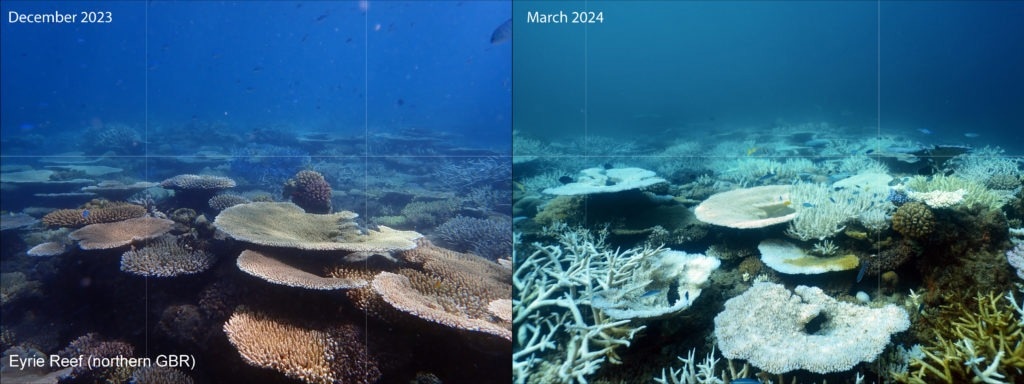New research suggests that certain deeper areas of the Great Barrier Reef are currently shielded from harmful heatwaves; however, this protective effect is at risk of being compromised if global warming persists.
 Photos taken before and after bleaching in the northern Great Barrier Reef near Lizard Island. Image Credit: Dr. George Roff
Photos taken before and after bleaching in the northern Great Barrier Reef near Lizard Island. Image Credit: Dr. George Roff
In five of the last eight years, high surface temperatures have caused the Great Barrier Reef to “bleach,” with the most recent instance occurring right now.
Sea surface temperatures are typically used in climate change estimates for coral reefs; However, this ignores the reality that deeper water does not always warm at the same rate as the surface.
The latest study, headed by the universities of Exeter and Queensland, examined how temperature changes will affect mesophotic corals, which are found in depths of 30 to 50 m.
Reefs can be protected from surface heatwaves by dividing warmer, buoyant surface water from cooler, deeper water. However, reef protection is lost if global warming surpasses 3 °C above pre-industrial levels.
The degree to which deeper water coral refuges exist and remain isolated from surface heatwaves will vary depending on local circumstances impacting how the water moves and mixes, the researchers say. Similar patterns could occur on other reefs globally.
Coral reefs are the canary in the coalmine, warning us of the many species and ecosystems affected by climate change. Coral bleaching is a dramatic sign of the impact humans are having on the planet. Our study offers both hope and a warning – hope that some reefs are resilient to current levels of climate change, and a warning that this resilience has its limits.
Dr. Jennifer McWhorter, Lead Research, University of Exeter
Dr. Jennifer McWhorter led the research during a QUEX PhD studentship at the universities of Exeter and Queensland.
According to the study, the Great Barrier Reef's mesophotic temperatures would rise over 30 °C, known to be the threshold for coral mortality, if global warming were to increase by 3 °C.
While this does not imply that all coral would perish, it would put the reef under stress, which could lead to a rise in mortality and even the collapse of the reef.
Dr. McWhorter, now at NOAA’s Atlantic Oceanographic & Meteorological Laboratory, said, “Some shallow-water species are not found in deeper areas – so mesophotic reefs cannot provide refuges for them as shallow reefs are degraded, and, as our study shows, mesophotic corals are themselves threatened if global warming continues.”
In estimating the warming of mesophotic reefs, the research team considered various aspects, such as tidal and wind-driven water mixing and local complexity.
According to its estimates, the Great Barrier Reef's (30–50 m) bottom temperatures will rise by 0.5–1°C with lower predicted greenhouse gas emissions and by 1.2–1.7 °C under higher emissions by 2050–60.
From Exeter’s Global Systems Institute, Dr. Paul Halloran said: “To protect coral reefs, we need to understand them better. Reefs face multiple threats – not just climate change. By targeting management of these threats on reefs that have the best chance of escaping the worst impacts of climate change, hopefully some healthy reefs can be maintained.”
There is so much to learn about deeper, tropical coral reefs, especially as we cannot assume that their depth provides a persistent refuge from the consequences of rising global carbon emissions.
Peter Mumby, Professor, University of Queensland
Journal Reference:
McWhorter, K. J., et al. (2024) Climate change impacts on mesophotic regions of the Great Barrier Reef. Proceedings of the National Academy of Sciences. doi.org/10.1073/pnas.2303336121